-
Paper Information
- Paper Submission
-
Journal Information
- About This Journal
- Editorial Board
- Current Issue
- Archive
- Author Guidelines
- Contact Us
Journal of Nuclear and Particle Physics
p-ISSN: 2167-6895 e-ISSN: 2167-6909
2017; 7(2): 23-26
doi:10.5923/j.jnpp.20170702.01

Effect of Alpha Particles on the Bulk Etching Rate of CR-39 Nuclear Track Detector
Hesham A. Yousef
Physics Department, Faculty of Science, Suez University, Suez, Egypt
Correspondence to: Hesham A. Yousef, Physics Department, Faculty of Science, Suez University, Suez, Egypt.
| Email: |  |
Copyright © 2017 Scientific & Academic Publishing. All Rights Reserved.
This work is licensed under the Creative Commons Attribution International License (CC BY).
http://creativecommons.org/licenses/by/4.0/

Solid state nuclear track detectors have different application in different branches of science, because it has been used as a passive system to detect the alpha particles. It is important to measure the bulk-etching rate for CR-39 detector, which is sensitive to all alpha particles reaching its surface at normal incidence. The effect of irradiation α-particles intensity emitted from 241Am with energy 5.49 MeV on CR-39 detector was studied. From the obtained results the values of bulk etching rate decrease with increasing alpha energy and the number of tracks increasing with increasing alpha energy. It is important to identify the time required for the chemical etching process at certain alpha energy.
Keywords: Detector, Irradiation, Alpha particles, Bulk Etching
Cite this paper: Hesham A. Yousef, Effect of Alpha Particles on the Bulk Etching Rate of CR-39 Nuclear Track Detector, Journal of Nuclear and Particle Physics, Vol. 7 No. 2, 2017, pp. 23-26. doi: 10.5923/j.jnpp.20170702.01.
1. Introduction
- CR-39 plastic nuclear track detectors (PNTDs) can also measure radiation from high energy, proton and neutrons through their secondary charged particles. The composition of CR-39 material is C12H18O7 and it’s sensitive to high linear energy transfer [1, 2]. Operation of the solid state nuclear track detector is based on the fact that a heavy charged particle will cause extensive ionization of the material when pass through it [3]. The passing of alpha particles through CR-39 sample causes ionization, which triggers a series of new chemical processes that result in the creation of free chemical radicals and other chemical species [4]. Charged particles deposit energy along their trail when they move through the matter of plastic materials. The energy loss creates a submicroscopic cylinder of 50-100 Aº radius of damaged molecules, so called latent track. Tracks formed in SSNTDs have different shapes, diameter and opacities depending on the energy and the angle of incidence of the alpha particles [5]. If, however, one places of the detector material in chemical etching solution, the volume around the latent track will be attacked preferentially, so that the track of the nuclear particle becomes visible by an optical microscope. For studying etched holes of nuclear tracks under an optical microscope, the plastic materials has of course to be transparent, the plastic detector material comes in sheets of 100-1000 µm thickness. The etching process or procedure, which results in the formation of visible tracks, can be described. For a plastic detector, we have actually two kinds of etching rate first the bulk or material etching rate VB µmh-1 at which the etching solution precedes along the latent track. The latter the track etching rate, depends on strongly on the energy loss of the ion. The formation of an etch cone around the path of an ion can be easily understood when we apply the Huygens principle [6]. The present work aimed to study the effect of alpha particles on the bulk etching rate of CR-39 detector, because the detector used as a monitor low level alpha particles contamination, which it is useful for radon and daughter monitoring.
2. Materials and Methods
- Forty nine pieces of CR-39 detector divided into seven groups were irradiated with different energies of alpha particles at the constant time. A pieces of CR-39 detector each of area 1.5x1.5 cm2 irradiate using a thin alpha source of 241Am was electroplated on a stainless steel disc with area 0.12 cm2, diameter 4 mm, activity 0.98µCi ± 5% = 3.63x 104 Bq. The alpha source used was a collimated 241Am has an alpha particles of energies 5.49 MeV. The energy of alpha particles at different distances in air was calculated. The alpha source is a bone seeking and long lived radionuclide (manufactured by Spectrum Techniques, Inc. Oak Ridge, USA). The detectors were irradiated in air using alpha source 241Am has an energy of 5.49 MeV, irradiation system consists of cupper collimator with 4mm diameter placed between the detector and the source at different distance which gives different energies. For counting tracks, we used only normal incidence alpha particles on the detectors as shown Figure 1. The figure was taken using optical microscope (Misr Fatrams 2011) of the magnification power lens 40x, and the CCD Camera (Hitachi Denshi, Ltd., model KP-M2E/K of lens with magnification power 62.5x, made in Japan and the total magnification power is 2500x. The energy at the surface of the detector was calculated using the following relation:
 | (1) |
 | (2) |
 | (3) |
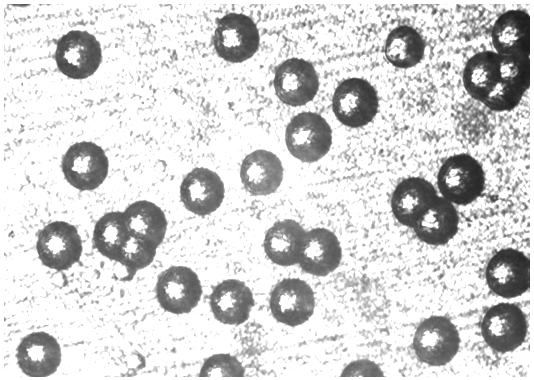 | Figure 1. Microphotograph of tracks for α-particles energy at normal incidence |
3. Results and Discussion
- The energy of alpha particles at different distance and the track density were given in Table 1. Figure 2 shows the relation between distance and energy of alpha particles and the correlation coefficient (R2 = 0.98), which is very good correlation and it is given importation a good results. The values of alpha energy decrease by increase the distance between the alpha source and the detector. Figure 3 shows the relation between energy of alpha particles and track density. This indicates that the values of track density increase with increasing alpha energy. The value of bulk etching rate was determined experimentally without irradiation and it equal 1.51 μmh-1 as shown in Figure 4. The relation between etching time and mass change of CR-39 detectors at different energies was given by Figure 5. Table 2 gives the values of the bulk etching rate at different energies. Figure 6 shows the relation between alpha particles energies and the values of the bulk etching rate of CR-39 detectors. From the figure we find that the values of the bulk etching rate decrease with increasing alpha energy, and the correlation coefficient equal (R2 = 0.94). This is a good correlation relation between alpha energies and the bulk etching rate of CR-39 detector. The highest value of bulk etching rate was found at energy 1.58 MeV, but the lowest value at 5.49 MeV, this means that the values of bulk etching rate inversely with energy value. This due to the value of diameter is directly proportional to the bulk etching rate, this is one of the methods set to determine bulk etching rate (D = 2VBt), but the values of diameter inversely with energy which reported by many authors [4, 12-14]. The obtained results in the present study have a good agreement with the results of other investigators in similar type of work.
|
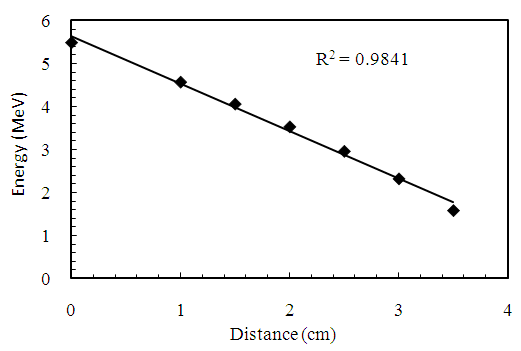 | Figure 2. The relation between distance and energy of alpha particles |
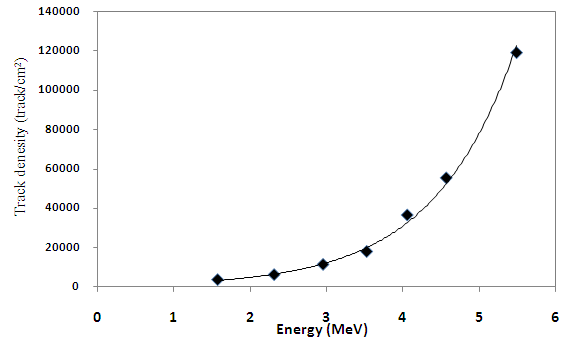 | Figure 3. The relation between energy of alpha particles and track density |
 | Figure 4. The relation between etching time and mass change without exposure to 241Am source |
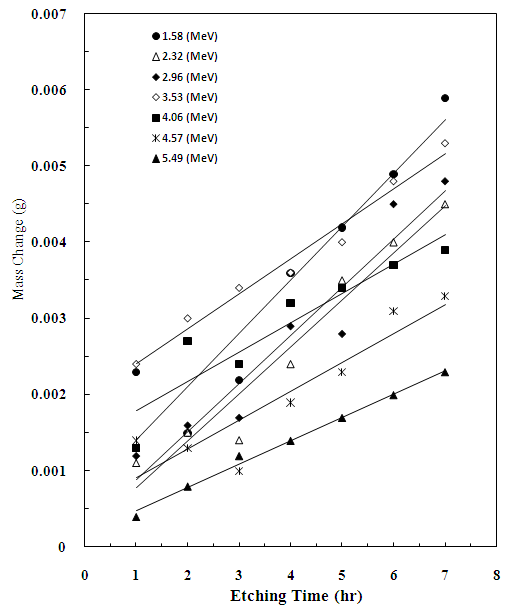 | Figure 5. The relation between etching time and mass change at exposure to alpha particles with different energy |
|
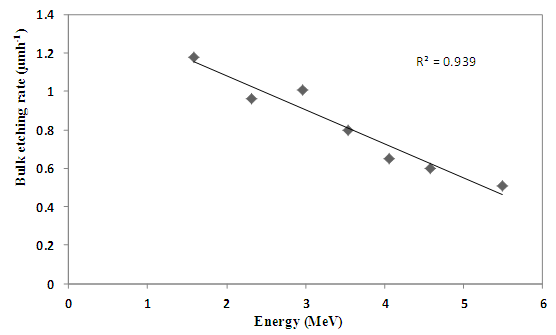 | Figure 6. The relation between alpha energy and bulk etching rate of CR-39 detector |
4. Conclusions
- CR-39 detectors have been used successfully as detecting devices to detect alpha contamination. The bulk etch rate is one of the crucial factors controlling tracks developments in nuclear track detectors. This work is presents the relation between the bulk etching rate of CR-39 detector and different alpha energies from 241Am source with different energies. The alpha particles destruction the place of the tracks only this means that the values of the bulk etching rate decrease with increasing the alpha energy this due to using more time to make the etching process for the CR-39 detectors it helps the emergence of clearly track shape. It is important to identify the time required for the chemical etching process at certain alpha energy.
 Abstract
Abstract Reference
Reference Full-Text PDF
Full-Text PDF Full-text HTML
Full-text HTML
